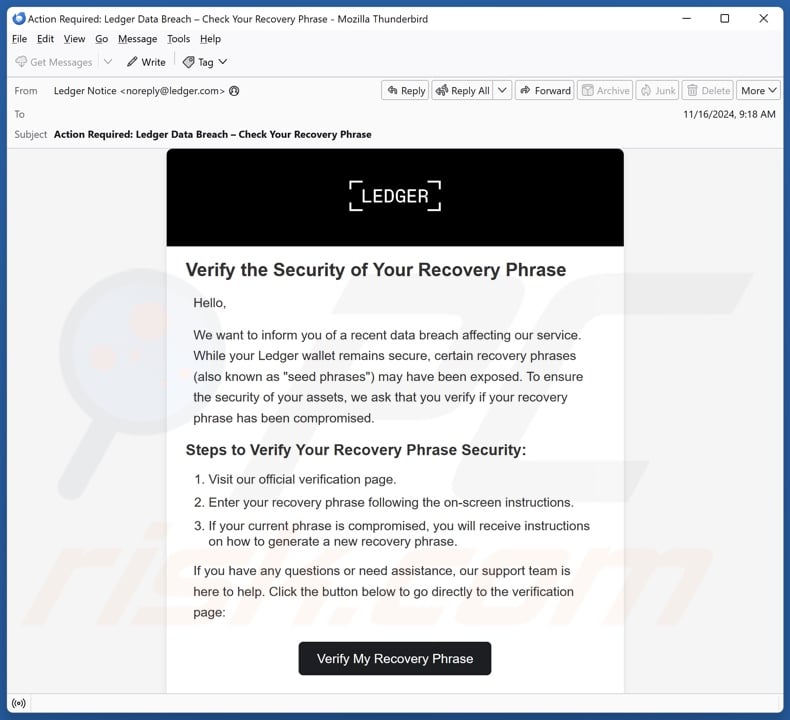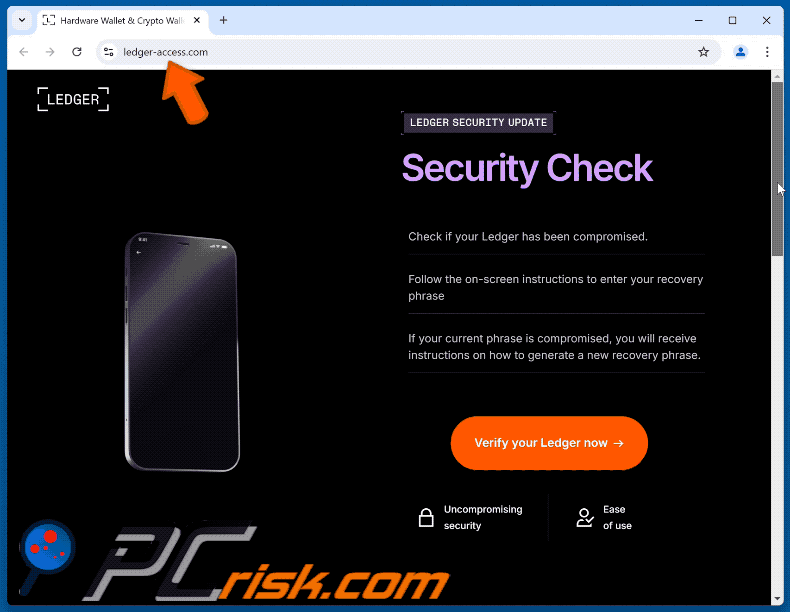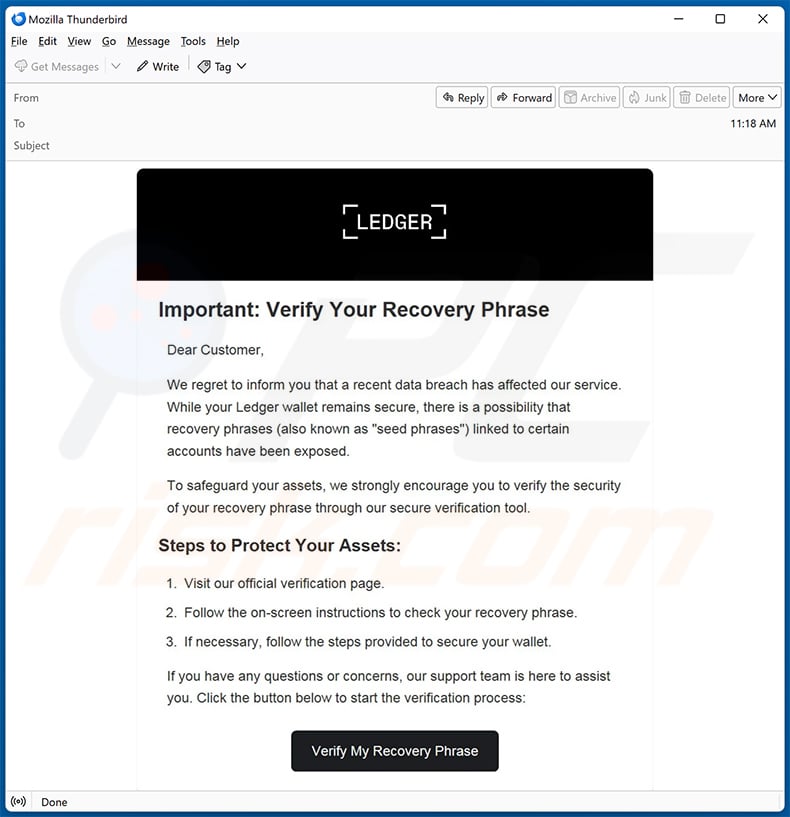Avoid getting scammed by fake "Ledger Recovery Phrase Verification" emails
Phishing/ScamAlso Known As: "Ledger Recovery Phrase Verification" phishing email
Get free scan and check if your device is infected.
Remove it nowTo use full-featured product, you have to purchase a license for Combo Cleaner. Seven days free trial available. Combo Cleaner is owned and operated by RCS LT, the parent company of PCRisk.com.
What kind of email is "Ledger Recovery Phrase Verification"?
After examining this "Ledger Recovery Phrase Verification" email, we learned that it is fake. This message falsely claims that the Ledger cryptocurrency wallet service has experienced a data breach, during which the log-in credentials of some cryptowallets might have been exposed.
Hence, the recipient is requested to verify whether their recovery phrase was compromised. This scam letter promotes a phishing website targeting wallet log-in credentials. It must be stressed that this email is fake and not associated with the real Ledger Company.

"Ledger Recovery Phrase Verification" email scam overview
The spam email with the subject "Action Required: Ledger Data Breach – Check Your Recovery Phrase" (may vary) states that Ledger has experienced a data breach. It has affected the service to the extent that the recovery phrases of some Ledger wallets may have been exposed.
Therefore, the recipient is urged to verify their cryptowallet to ascertain whether theirs have been affected. This can be done through the linked "official verification page" by providing the passphrase and, if it was compromised, following the on-screen instructions on generating a new one.
It must be reiterated that the information in this email is false, and this mail is not associated with the actual Ledger wallet or its developers.
After the "Verify My Recovery Phrase" button is pressed, it results in a redirect to a phishing page masquerading as Ledger's official website. Data provided to phishing sites is recorded and sent to scammers. Hence, cryptowallet log-in credentials entered into this fraudulent site are revealed to cyber criminals, thereby enabling them to steal the wallets and the digital assets stored therein.
It must be mentioned that cryptocurrency transactions cannot be reversed because of their practically untraceable nature. Therefore, victims of such scams cannot recover their assets.
| Name | "Ledger Recovery Phrase Verification" phishing email |
| Threat Type | Phishing, Scam, Social Engineering, Fraud |
| Fake Claim | Recipient must verify their wallet to check whether its passphrase has been compromised. |
| Disguise | Ledger |
| Related Domains | ledger-center[.]com, ledger-access[.]com, verify-seed[.]com, ledger-recovery[.]info |
| Detection Names (ledger-access[.]com) | Fortinet (Phishing), G-Data (Phishing), Sophos (Phishing), Webroot (Malicious), Full List Of Detections (VirusTotal) |
| Serving IP Address (ledger-access[.]com) | 172.67.166.145 |
| Symptoms | Unauthorized online purchases, changed online account passwords, identity theft, illegal access of the computer. |
| Distribution methods | Deceptive emails, rogue online pop-up ads, search engine poisoning techniques, misspelled domains. |
| Damage | Loss of sensitive private information, monetary loss, identity theft. |
| Malware Removal (Windows) |
To eliminate possible malware infections, scan your computer with legitimate antivirus software. Our security researchers recommend using Combo Cleaner. Download Combo CleanerTo use full-featured product, you have to purchase a license for Combo Cleaner. 7 days free trial available. Combo Cleaner is owned and operated by RCS LT, the parent company of PCRisk.com. |
Phishing spam campaign examples
We have written about countless spam campaigns; "Account Lockdown Notification", "Payment Notification", "Two-Factor Authentication (2FA)", "Blockchain Rewards", and "Server Detected Network Error #404" are merely some of our latest articles on phishing emails.
Aside from various log-in credentials, this mail often targets personally identifiable information and finance-related data. Spam emails promote other scams and distribute malware.
Various false claims are used to gain and subsequently abuse recipients' trust, such as detected threats, security upgrades, account issues, subscription cancellations/renewals, purchases/invoices, business offers, inheritances, lotteries, etc.
Due to how widespread spam mail is and how well-made it can be – we highly recommend approaching incoming emails, PMs/DMs, SMSes, and other messages with caution.
How do spam campaigns infect computers?
Spam campaigns proliferate malware by distributing malicious files as attachments or download links. These files can be documents (Microsoft Office, Microsoft OneNote, PDF, etc.), archives (ZIP, RAR, etc.), executables (.exe, .run, etc.), JavaScript, and so on.
Merely opening such a file can be enough to trigger malware download/installation. Some formats need additional actions to initiate system infection processes. For example, Microsoft Office files require users to enable macro commands (i.e., editing/content), while OneNote documents need them to click on embedded files or links.
How to avoid installation of malware?
We strongly recommend approaching incoming emails and other messages with care. Attachments or links present in suspect/irrelevant mail must not be opened, as they can be virulent.
However, malware is spread using various techniques. Therefore, we advise being vigilant when browsing since the Internet is rife with deceptive and malicious content.
Additionally, all downloads must be performed from official and verified sources. Another recommendation is to activate and update programs using legitimate functions/tools, as illegal activation tools ("cracks") and third-party updates can contain malware.
We must emphasize the importance of having a reputable anti-virus installed and kept up-to-date. Security software must be used to run regular system scans and to remove detected threats and issues. If you've already opened malicious attachments, we recommend running a scan with Combo Cleaner Antivirus for Windows to automatically eliminate infiltrated malware.
Text presented within this email:
Subject: Action Required: Ledger Data Breach – Check Your Recovery Phrase
LEDGER
Verify the Security of Your Recovery PhraseHello,
We want to inform you of a recent data breach affecting our service. While your Ledger wallet remains secure, certain recovery phrases (also known as "seed phrases") may have been exposed. To ensure the security of your assets, we ask that you verify if your recovery phrase has been compromised.
Steps to Verify Your Recovery Phrase Security:Visit our official verification page.
Enter your recovery phrase following the on-screen instructions.
If your current phrase is compromised, you will receive instructions on how to generate a new recovery phrase.If you have any questions or need assistance, our support team is here to help. Click the button below to go directly to the verification page:
Verify My Recovery Phrase© 2024 Ledger. All rights reserved. | www.ledger.com
Appearance of the fake Ledger website promoted by this spam campaign (GIF):

Another example of an email from "Ledger Recovery Phrase Verification" spam campaign:

Text presented within:
LEDGER
Important: Verify Your Recovery Phrase
Dear Customer,
We regret to inform you that a recent data breach has affected our service. While your Ledger wallet remains secure, there is a possibility that recovery phrases (also known as "seed phrases") linked to certain accounts have been exposed.
To safeguard your assets, we strongly encourage you to verify the security of you recovery phrase through our secure verification tool.
Steps to Protect Your Assets:
1. Visit our official verification page.
2. Follow the on-screen instructions to check your recovery phrase.
3. If necessary, follow the steps provided to secure your wallet.
If you have any questions or concerns, our support team is here to assist you. Click the button below to start the verification process:
[Verify My Recovery Phrase]
Instant automatic malware removal:
Manual threat removal might be a lengthy and complicated process that requires advanced IT skills. Combo Cleaner is a professional automatic malware removal tool that is recommended to get rid of malware. Download it by clicking the button below:
DOWNLOAD Combo CleanerBy downloading any software listed on this website you agree to our Privacy Policy and Terms of Use. To use full-featured product, you have to purchase a license for Combo Cleaner. 7 days free trial available. Combo Cleaner is owned and operated by RCS LT, the parent company of PCRisk.com.
Quick menu:
- What is "Ledger Recovery Phrase Verification" phishing email?
- Types of malicious emails.
- How to spot a malicious email?
- What to do if you fell for an email scam?
Types of malicious emails:
![]() Phishing Emails
Phishing Emails
Most commonly, cybercriminals use deceptive emails to trick Internet users into giving away their sensitive private information, for example, login information for various online services, email accounts, or online banking information.
Such attacks are called phishing. In a phishing attack, cybercriminals usually send an email message with some popular service logo (for example, Microsoft, DHL, Amazon, Netflix), create urgency (wrong shipping address, expired password, etc.), and place a link which they hope their potential victims will click on.
After clicking the link presented in such email message, victims are redirected to a fake website that looks identical or extremely similar to the original one. Victims are then asked to enter their password, credit card details, or some other information that gets stolen by cybercriminals.
![]() Emails with Malicious Attachments
Emails with Malicious Attachments
Another popular attack vector is email spam with malicious attachments that infect users' computers with malware. Malicious attachments usually carry trojans that are capable of stealing passwords, banking information, and other sensitive information.
In such attacks, cybercriminals' main goal is to trick their potential victims into opening an infected email attachment. To achieve this goal, email messages usually talk about recently received invoices, faxes, or voice messages.
If a potential victim falls for the lure and opens the attachment, their computers get infected, and cybercriminals can collect a lot of sensitive information.
While it's a more complicated method to steal personal information (spam filters and antivirus programs usually detect such attempts), if successful, cybercriminals can get a much wider array of data and can collect information for a long period of time.
![]() Sextortion Emails
Sextortion Emails
This is a type of phishing. In this case, users receive an email claiming that a cybercriminal could access the webcam of the potential victim and has a video recording of one's masturbation.
To get rid of the video, victims are asked to pay a ransom (usually using Bitcoin or another cryptocurrency). Nevertheless, all of these claims are false - users who receive such emails should ignore and delete them.
How to spot a malicious email?
While cyber criminals try to make their lure emails look trustworthy, here are some things that you should look for when trying to spot a phishing email:
- Check the sender's ("from") email address: Hover your mouse over the "from" address and check if it's legitimate. For example, if you received an email from Microsoft, be sure to check if the email address is @microsoft.com and not something suspicious like @m1crosoft.com, @microsfot.com, @account-security-noreply.com, etc.
- Check for generic greetings: If the greeting in the email is "Dear user", "Dear @youremail.com", "Dear valued customer", this should raise suspiciousness. Most commonly, companies call you by your name. Lack of this information could signal a phishing attempt.
- Check the links in the email: Hover your mouse over the link presented in the email, if the link that appears seems suspicious, don't click it. For example, if you received an email from Microsoft and the link in the email shows that it will go to firebasestorage.googleapis.com/v0... you shouldn't trust it. It's best not to click any links in the emails but to visit the company website that sent you the email in the first place.
- Don't blindly trust email attachments: Most commonly, legitimate companies will ask you to log in to their website and to view any documents there; if you received an email with an attachment, it's a good idea to scan it with an antivirus application. Infected email attachments are a common attack vector used by cybercriminals.
To minimise the risk of opening phishing and malicious emails we recommend using Combo Cleaner Antivirus for Windows.
Example of a spam email:

What to do if you fell for an email scam?
- If you clicked on a link in a phishing email and entered your password - be sure to change your password as soon as possible. Usually, cybercriminals collect stolen credentials and then sell them to other groups that use them for malicious purposes. If you change your password in a timely manner, there's a chance that criminals won't have enough time to do any damage.
- If you entered your credit card information - contact your bank as soon as possible and explain the situation. There's a good chance that you will need to cancel your compromised credit card and get a new one.
- If you see any signs of identity theft - you should immediately contact the Federal Trade Commission. This institution will collect information about your situation and create a personal recovery plan.
- If you opened a malicious attachment - your computer is probably infected, you should scan it with a reputable antivirus application. For this purpose, we recommend using Combo Cleaner Antivirus for Windows.
- Help other Internet users - report phishing emails to Anti-Phishing Working Group, FBI’s Internet Crime Complaint Center, National Fraud Information Center and U.S. Department of Justice.
Frequently Asked Questions (FAQ)
Why did I receive this email?
Spam emails are not personal, even if they include information relevant to the recipients. This mail is sent out in massive operations – therefore, thousands of users receive identical or incredibly similar emails.
I have provided my personal information when tricked by this spam email, what should I do?
If you have provided your log-in credentials – immediately change the passwords/passphrases of all possibly exposed accounts and inform their official support. If you've disclosed other private data (e.g., ID card details, passport scans/photos, credit card numbers, etc.) – contact relevant authorities without delay.
I have read a spam email but didn't open the attachment, is my computer infected?
Merely reading an email is harmless; systems are infected when malicious attachments or links are opened/clicked.
I have downloaded and opened a file attached to a spam email, is my computer infected?
Whether the system was infected might depend on the opened file's format. Once opened, executables (.exe, .run, etc.) cause infections almost without fail. However, some other formats – like documents (.doc, .xls, .pdf, .one, etc.) – may need additional user interaction. Hence, malware download/installation can only be jumpstarted after macros are enabled, embedded content is clicked, or other actions are performed.
Will Combo Cleaner remove malware infections present in email attachments?
Combo Cleaner is designed to scan devices and remove all kinds of threats. It is capable of detecting and eliminating most of the known malware infections. Note that performing a full system scan is essential – since sophisticated malicious programs usually hide deep within systems.
Share:

Tomas Meskauskas
Expert security researcher, professional malware analyst
I am passionate about computer security and technology. I have an experience of over 10 years working in various companies related to computer technical issue solving and Internet security. I have been working as an author and editor for pcrisk.com since 2010. Follow me on Twitter and LinkedIn to stay informed about the latest online security threats.
PCrisk security portal is brought by a company RCS LT.
Joined forces of security researchers help educate computer users about the latest online security threats. More information about the company RCS LT.
Our malware removal guides are free. However, if you want to support us you can send us a donation.
DonatePCrisk security portal is brought by a company RCS LT.
Joined forces of security researchers help educate computer users about the latest online security threats. More information about the company RCS LT.
Our malware removal guides are free. However, if you want to support us you can send us a donation.
Donate
▼ Show Discussion